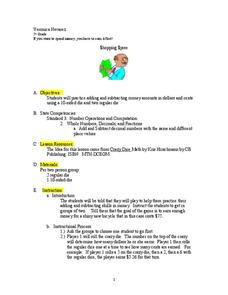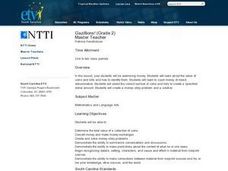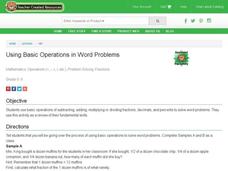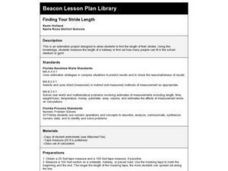Curated OER
Shopping Spree
Sixth graders examine currency by completing monetary equations. In this economics lesson, 6th graders participate in a numbers experiment where they roll a die and earn money based on their roll. Students compete for their fictitious...
Curated OER
Mixing Coins
Young scholars explore mixed (different denomination) coin sets and create different total amounts.
Curated OER
Math/Technology: Coin Combos
Second graders identify coin combinations needed to purchase items under a dollar. Using Kidspiration, they demonstrate three ways to purchase a pizza slice for 96 cents and choose an item which cost less than a dollar for other to...
Curated OER
Gazillions!
Second graders determine the total value of a collection of coins. They convert money and make money exchanges. Students create and solve money-story problems. They demonstrate the ability to summarize conversations and discussions.
Curated OER
Is the Price Right?
Students listen to the book, Arthur's Funny Money, then play The Price is Right game to estimate and to chart the price of items to the nearest $1.00 and $10.00. They check their estimates by counting out the actual amount in play money.
Curated OER
Fractional Parts of a Number
In this fractional parts of a number activity, students read and solve 6 story problems that pertain to fractional parts of a whole number.
Curated OER
Equal Groups
In this dividing by two word problem instructional activity, students use pictures and mental math to problem solve. Students solve six problems.
Curated OER
What's the Chance?
Students conduct probability experiments with dice and coins. They watch a video for a variety of situations where calculating the probability is complicated by total number of possibilities. They solve problems presented in the video.
Curated OER
Halloween
Pupils solve Halloween word problems to work on their math skills. In this Halloween lesson plans, students solve problems involving candy, costumes, money, kids, and more.
Curated OER
Million Dollar Project
Each student is given the task of spending $1 million. The way students spend their money is dependent on a theme such as "creating a dream world," "taking a trip," or "doing something to better society." Each student researches,...
Curated OER
Chances Are...
Students examine the probability of an event. In this probability lesson, students determine whether it is likely that an event will occur in coin flipping activities. They work with two and four coins, and one die in three different...
Curated OER
Thinking About Credit
Students explore the concept of credit. In this credit lesson, students discuss what it means to buy items using credit. Students discuss how interest accrues and how much is really being paid with a credit card. Students calculate...
Curated OER
Using Basic Operations in Word Problems
Students review basic operations and use them to solve word problems. In this word problems lesson, students review basic mathematical operations such as addition, subtraction, multiplication, and division. Students then complete an...
Curated OER
Problem Solving: Use a Simpler Problem
In this problem solving worksheet, 5th graders focus on using a simpler problem to solve 6 word problems. They work with decimals, fractions, times, and money.
Curated OER
Estimate Quotients
Fifth graders have to use division to solve problems in everyday situations. This activity on estimation and division has students practice these skills using real-life examples. The activity is part of the Houghton Mifflin math series...
Curated OER
Figuring Elapsed Time
Students tell time. In this elapsed time instructional activity, students review how to tell time to five minutes. Students solve problems where they must determine the elapsed time.
Curated OER
Planning and Shopping for the Menu
Students plan a menu considering the number of people to be served and the amount of money they have to work with to buy the necessary ingredients.
Curated OER
Finding Your Stride Length
Pupils participate in an estimation activity to determine the length of a hallway or to estimate how many people can fit in the school stadium or gym.
Curated OER
Investigating the Probability
Students investigate probability using coins and dice. They collect data, graph, organize and interpret data. They predict, describe, compare, compute and draw conclusions based on what they observe and record.
Curated OER
Problem Solving: Work Backward
In this problem solving learning exercise, 4th graders solve each of 6 word problems by working backwards. They use the strategy while working with money and decimals.
Curated OER
Leveled Problem Solving Multiplying and Dividing Decimals
In order to be able to multiply and divide decimals properly, students need to be provided with a variety of ways to practice this skill. In this basic activity, students practice how to multiply and divide decimals using word problems...
Curated OER
Fractions and Mixed Numbers
Converting fractions is an important skill for students to master. Using this worksheet, students can practice expressing fractions as an improper fraction and as a mixed number. This worksheet is for use with the Houghton Mifflin math...
Curated OER
Dynamite Data
Second graders rotate through a variety of stations designed to offer practice in manipulating data. They sort, tally and count items and then create bar graphs, tables, and pie graphs to record their findings.
EngageNY
More Examples of Functions
Discrete or not discrete? Individuals learn about the difference between discrete and non-discrete functions in the fourth installment of a 12-part module. They classify some examples of functions as being either discrete or non-discrete.

























